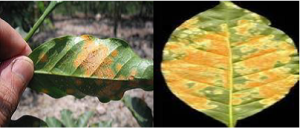Coffee leaf rust

Disease symptoms:
Infection occurs on the coffee leaves.
The first observable symptoms are small, pale yellow spots on the upper surface of the leaves.
As these spots gradually increase in diameter, mass of orange urediniospores (uredospores) appear on the undersurface.
The fungus sporulates through the stomata rather than breaking through the epidermis as most rusts do, so it does not form the pustules typical of many rusts.
The powdery lesions on the underside of the leaves can be orange-yellow to red-orange in color, and this colour expression has considerable variation from one region to another.
Survival and spread:
Hemileia vastatrix survives primarily as mycelium in the living tissues of the host, and since infected leaves drop prematurely; this effectively removes a huge amount of potential inoculum from the epidemic.
But a few green leaves always persist through the dry season, and dry urediniospores can survive about 6 weeks, so there is always some viable inoculum to infect the newly formed leaves at the start of the next rainy season.
Favorable conditions:
Rain or dew, high humidity. The whole process of infection requires about 24 to 48 hours of continuous free moisture, so while heavy dew is enough to stimulate urediniospore germination, infection usually occurs only during the rainy season.
Control:
Use of resistant varieties
The use of rust-resistant coffee cultivars is considered the best method for managing the disease in the long term. A cultivar is a plant variety produced by selective breeding. However, coffee growers still have little knowledge about the advantages of new cultivars.
Biological Controls:
The use of biopesticides seems to effectively reduce the damage caused by coffee rust by up to 97%. These products include plant extracts, which stimulate a chemical defense reaction in the plants. Thus, these products may induce resistance against the disease. This makes them a promising alternative in disease management. The use of essential oils such as cinnamon, citronella, lemongrass, cloves, tea tree, thyme and eucalyptus has also shown promising results in coffee rust management.
Chemical Control:
There are several fungicides that can be used to protect plants from infection. Mancozeb as a protectant and myclobutanil as an eradicant are generally effective against all rusts while triadimefon is effective against only specific rusts.





